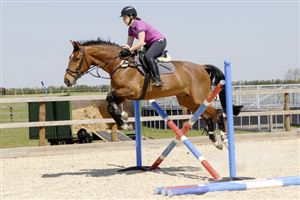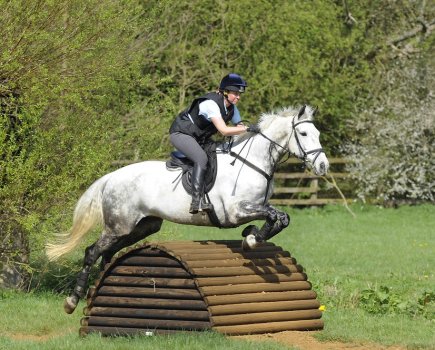 From verticals to triple bars, show jumper Mia Palles Clarke explains how different fences and elements can help your horse become a more athletic, careful jumper.
From verticals to triple bars, show jumper Mia Palles Clarke explains how different fences and elements can help your horse become a more athletic, careful jumper.
Ground poles
Really boost your horse’s bascule by using ground poles to create a wider fence base – he’ll instinctively know what to do. Without a ground line a fence becomes more advanced, drawing your horse in close, making it harder for him to jump well and get his legs out of the way in time.
You can also make a V-shape with ground poles before fences to channel your horse’s energy on approach, helping produce a much better jump.
Cross-poles
A great warm-up and schooling fence, cross-poles help your horse start to open up and use his shoulders. The V-shape encourages him to come centrally to the fence, tuck his knees neatly up and to look at what he’s being asked to jump. The taller the cross-pole, the more it will improve his action, as he works those shoulders and really lifts up.
Vertical
A vertical (or upright) is made of poles in the same vertical plane, and encourages your horse to make a taller, rounder shape in his jump. The take-off and landing spots will be the same distance away from the fence, so your horse will make quite a steep shape into it, lifting his shoulders higher vertically and tucking his forelegs up and away quite quickly.
Fillers
Fillers are great for getting a round shape in your horse’s jump, and by creating an illusion of solid colour he’ll really look at what he’s facing. They’re great for a bold horse because they demand respect, but if he’s lacking in confidence, fillers can make a fence harder to ride.
Planks
Planks work the same way as a vertical, creating a tall, steep jump shape, but they’re easier to knock down as they sit on flat cups. Planks create a more solid-looking fence, so your horse may back off a bit, and even produce a bigger jump, and as they tend not to have a ground line, they’ll draw him in quite deep, so he needs a more powerful jump to clear them!
Triple bar
Made with three poles of ascending height, triple bars create a longer, more open jump. Your horse really has to stretch and lift his front end to clear them, and they can be challenging when linked with other fences. Because their width requires more power, your horse will come deeper into the fence before take-off and land further out than normal, so if you’re working out your strides to the next fence keep this in mind.
Oxers
Two parallel vertical fences form an oxer, creating a spread that gets horses up in the air, producing a rounder, more equal shape than a triple bar encourages with take-off and landing spots the same distance from the fence. Because of the power your horse uses to push himself up and over, he may run on a little on landing, or lack energy because he used it up in the air.
Liverpool
A Liverpool is a vertical or oxer with a ditch or large tray of water underneath. The tray makes your horse look at the fence (which can cause his head and neck to drop as he approaches) then encourages him to get up in the air, creating a large, round jump.
Place the tray in front of the fence and it mimics the effect of a triple bar, encouraging a wider, more open jump which rises gradually. Place the tray under the fence or out behind it and your horse will draw deep into the fence, producing a more upright take-off and more reach as he lands.
If you don’t have a water tray, you can create the same effect by laying something on the ground beneath a fence such as a rug.








